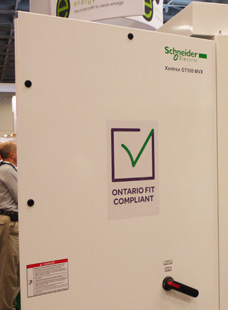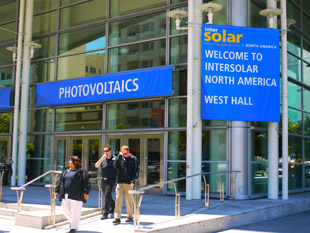
Marketing Ontario Content at Intersolar
San Francisco, 15 July 2010 – There has been considerable controversy generated in the aftermath of the recently proposed changes to the Ontario Solar PV Feed-in-Tariff (FIT), just as support for its novel and controversial Domestic Content provisions is growing.
The Ontario Power Authority (OPA) held two Public Consultations last week – on July 6 and July 8 – to summarize and discuss its proposed rate reduction for MicroFIT (less than 10 kW) ground mount PV projects while separating these projects from similar sized roofmount installations. These two OPA webinars drew strong criticism from many of those who are actively involved in the program.
Adam Webb, President of Sentinel Power Systems, for example, was featured in a PHOTON Magazine February 2010 article indicating how his business had grown 50-fold in 2009 as a result of the new FIT program. In last week’s OPA meeting, however, Webb expressed concerns about his business and echoed the sentiments of many fellow participants in discussing potential market instability that may have been created by the proposed changes. Like a number of callers, he also questioned the further delay in processing applications asking, “How many of the (11,000 pending ground mount applications) would actually be able to be installed by the end of the year (particularly given the added delay to review these proposed changes)? I cannot see any way that 11,000 (MicroFIT projects) can be installed by the end of the year.”
This installation timing is important as the current applications have been submitted under 40% Domestic Content guidelines for 2010 MicroFIT projects. This 40% content requirement will increase to 60% in 2011. Thus, applicants, suppliers and installers looking to comply with the current 40% provisions are being strained by the additional 30 day review period for the OPA proposed program changes. When asked directly in last week’s meetings about whether the OPA would amend the domestic content requirements in any way, Jim MacDougall, the OPA’s Manager Distributed Generation Electricity Resources, firmly stated, “There is no consideration to extend the Dec 31 deadline for MicroFIT projects. Proponents will have to work towards getting their projects in 2010 to be eligible for that lower 40% for MicroFIT projects.”
At the same time as the proposed changes to the MicroFIT program are generating controversy, there have been a number of new announcements from manufacturers such as Samco Solar and MEMC’s SunEdison to comply with and support the FIT Program’s Domestic Content provisions.

Intersolar America in San Francisco
Today at the Intersolar Convention here in San Francisco, for example, Schneider Electric is displaying its equipment with prominent signage proclaiming “Ontario FIT Compatible”. The number of Ontario based PV inverter and microinverter manufacturers has gone from barely one a year ago to as many as ten today. Newcomer Sparq Systems Inc., for example, announced its new Ontario microinverters here at Intersolar yesterday.
Similarly, yesterday’s NY Times provided an article on a new Calisolar financing. A number of industry experts here at Intersolar have questioned whether proceeds from that financing will be targeted towards increased production of Ontario polysilicon from its 6N Silicon subsidiary. An expansion of that facility could help the company profit from its Ontario factory’s Domestic Content. Notably the NY Times article also revealed that Calisolar had added John Correnti as Chairman. 6N Silicon’s UMG has been cited as a disruptive innovation in the polysilicon market, and Mr. Correnti’s previous company Nucor Steel is a classically cited example of successful disruptive innovation strategy.
Certainly the recently proposed changes in Ontario’s PV Feed-In-Tariff program have caused some disruption in what has been a popular, albeit controversial, program.




No Responses to “Ontario FIT Program Changes Generate Controversy amid Compliance”
Trackbacks/Pingbacks